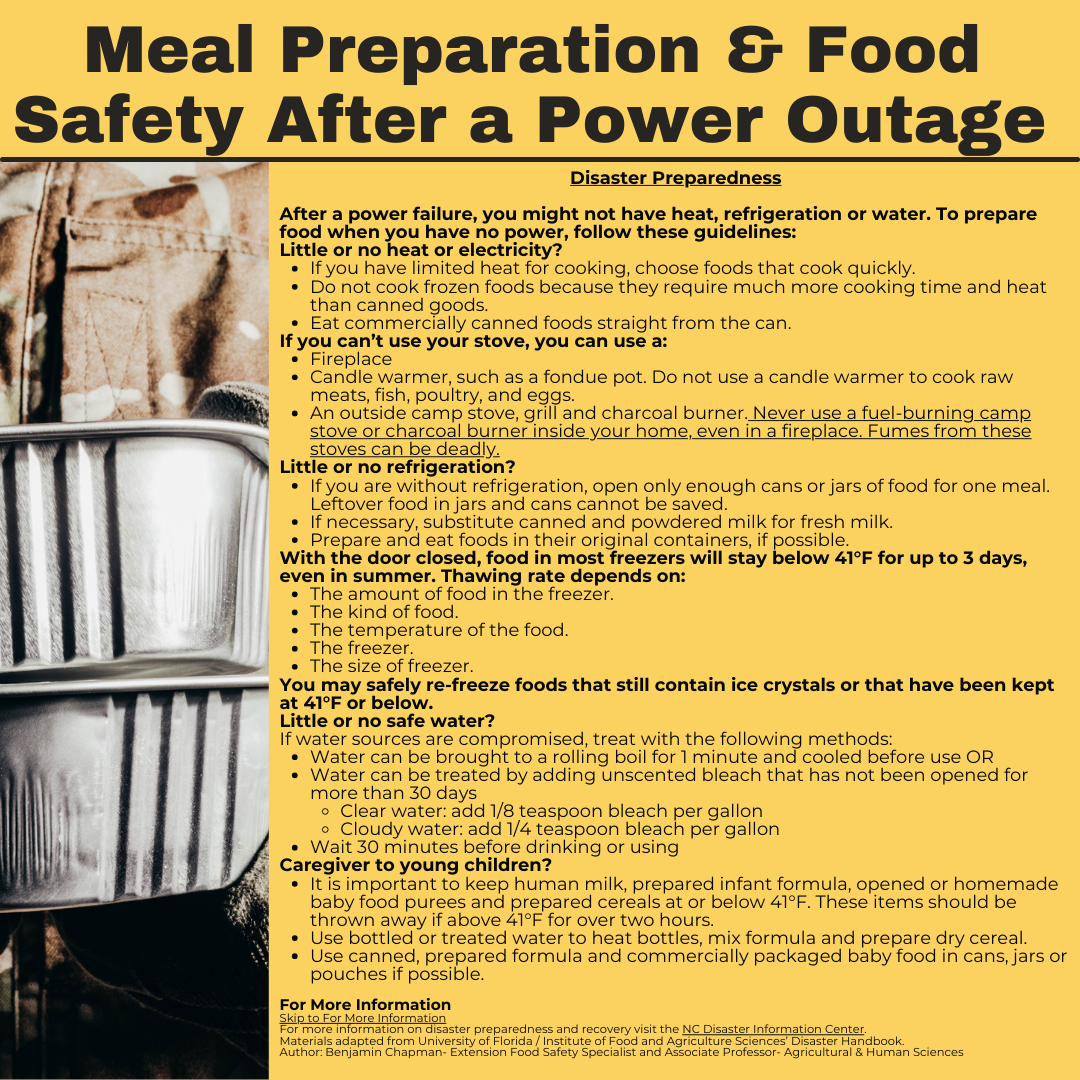Meal Prep & Food Safety After a Power Outage
go.ncsu.edu/readext?1030091
en Español / em Português
El inglés es el idioma de control de esta página. En la medida en que haya algún conflicto entre la traducción al inglés y la traducción, el inglés prevalece.
Al hacer clic en el enlace de traducción se activa un servicio de traducción gratuito para convertir la página al español. Al igual que con cualquier traducción por Internet, la conversión no es sensible al contexto y puede que no traduzca el texto en su significado original. NC State Extension no garantiza la exactitud del texto traducido. Por favor, tenga en cuenta que algunas aplicaciones y/o servicios pueden no funcionar como se espera cuando se traducen.
Português
Inglês é o idioma de controle desta página. Na medida que haja algum conflito entre o texto original em Inglês e a tradução, o Inglês prevalece.
Ao clicar no link de tradução, um serviço gratuito de tradução será ativado para converter a página para o Português. Como em qualquer tradução pela internet, a conversão não é sensivel ao contexto e pode não ocorrer a tradução para o significado orginal. O serviço de Extensão da Carolina do Norte (NC State Extension) não garante a exatidão do texto traduzido. Por favor, observe que algumas funções ou serviços podem não funcionar como esperado após a tradução.
English
English is the controlling language of this page. To the extent there is any conflict between the English text and the translation, English controls.
Clicking on the translation link activates a free translation service to convert the page to Spanish. As with any Internet translation, the conversion is not context-sensitive and may not translate the text to its original meaning. NC State Extension does not guarantee the accuracy of the translated text. Please note that some applications and/or services may not function as expected when translated.
Collapse ▲After a power failure, you might not have heat, refrigeration or water. To prepare food when you have no power, follow these guidelines:
Little or no heat or electricity?
- If you have limited heat for cooking, choose foods that cook quickly.
- Do not cook frozen foods because they require much more cooking time and heat than canned goods.
- Eat commercially canned foods straight from the can.
If you can’t use your stove, you can use a:
- Fireplace
- Candle warmer, such as a fondue pot. Do not use a candle warmer to cook raw meats, fish, poultry, and eggs.
- An outside camp stove, grill and charcoal burner. Never use a fuel-burning camp stove or charcoal burner inside your home, even in a fireplace. Fumes from these stoves can be deadly.
Little or no refrigeration?
- If you are without refrigeration, open only enough cans or jars of food for one meal. Leftover food in jars and cans cannot be saved.
- If necessary, substitute canned and powdered milk for fresh milk.
- Prepare and eat foods in their original containers, if possible.
With the door closed, food in most freezers will stay below 41°F for up to 3 days, even in summer. Thawing rate depends on:
- The amount of food in the freezer.
- The kind of food.
- The temperature of the food.
- The freezer.
- The size of freezer.
You may safely re-freeze foods that still contain ice crystals or that have been kept at 41°F or below.
Little or no safe water?
If water sources are compromised, treat with the following methods:
- Water can be brought to a rolling boil for 1 minute and cooled before use OR
- Water can be treated by adding unscented bleach that has not been opened for more than 30 days
- Clear water: add 1/8 teaspoon bleach per gallon
- Cloudy water: add 1/4 teaspoon bleach per gallon
- Wait 30 minutes before drinking or using
Caregiver to young children?
- It is important to keep human milk, prepared infant formula, opened or homemade baby food purees and prepared cereals at or below 41°F. These items should be thrown away if above 41°F for over two hours.
- Use bottled or treated water to heat bottles, mix formula and prepare dry cereal.
- Use canned, prepared formula and commercially packaged baby food in cans, jars or pouches if possible.
For More Information
For more information on disaster preparedness and recovery visit the NC Disaster Information Center.
Materials adapted from University of Florida / Institute of Food and Agriculture Sciences’ Disaster Handbook.
Author: Benjamin Chapman- Extension Food Safety Specialist and Associate Professor- Agricultural & Human Sciences





